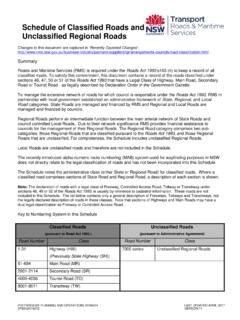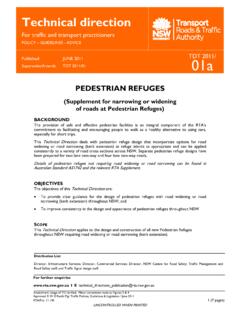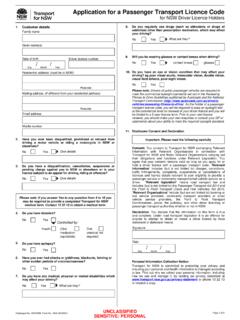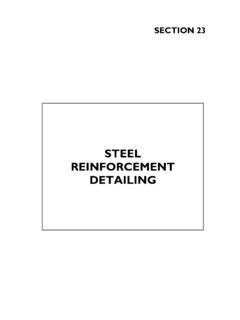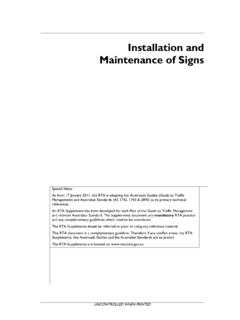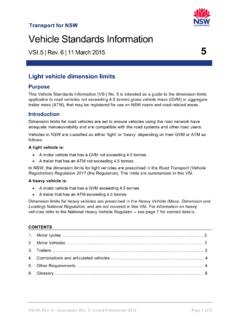Transcription of M209 Road Openings and Restoration - Transport for NSW
1 Transport FOR NSW (TfNSW). QA SPECIFICATION TfNSW m209 . road Openings AND Restoration . NOTICE. This document is a Transport for NSW QA Specification. It has been developed for use with roadworks and bridgeworks contracts let by Transport for NSW or by local councils in NSW. It is not suitable for any other purpose and must not be used for any other purpose or in any other context. Copyright in this document belongs to Transport for NSW. REVISION REGISTER. Ed/Rev Clause Authorised Description of Revision Date Number Number By Ed 1/Rev 0 New Specification GM, IC Ed 2/Rev 0 All General technical review, and revision of some technical requirements.
2 Format GM, IAM revised. Ed 2/Rev 1 , Referenced Documents updated. MCQ Annex Ed 2/Rev 2 Global References to Roads and Maritime DCS Services or RMS changed to Transport for NSW or TfNSW respectively. Ed 2/Rev 3 Annex , Reference to AS/NZS 4360 changed to AS SMCSp ISO 31000. Edition 2 / Revision 3 Transport FOR NSW. August 2021. GUIDE NOTES. (Not Part of Contract Document). THESE NOTES ARE NOT PART OF THE SPECIFICATION, CONTRACT OR AGREEMENT. The following notes are intended to provide guidance to TfNSW personnel on the application of the Specification. They do not form part of the Specification, Contract or Agreement.
3 USING TFNSW m209 . TfNSW m209 has been developed mainly for use by third parties undertaking road opening work within an existing trafficked pavement on a State road for the purpose of buried public utilities, services or drainage. m209 may also be used for road opening work carried out by or for the TfNSW, with appropriate amendment to third party administrative provisions ( Proponent becomes TfNSW ). m209 must not be used for any excavation or pavement Restoration work other than for road Openings ( concrete slab replacement, heavy patching or pavement reconstruction). This specification should be read in conjunction with the issued road OPENING APPROVAL and road .
4 OCCUPANCY LICENCE (DEVELOPMENT ACTIVITIES) for the road opening. OUTLINE OF m209 . Format and Appropriate Use of m209 . m209 is designed to be a stand alone specification with minimal cross-referencing to other TfNSW. specifications. It assumes little knowledge of TfNSW requirements and documentation. There is some cross-referencing to TfNSW materials specifications in Clause 3, where suppliers need to be (and are likely to be) familiar with TfNSW requirements. Such cross-referencing is avoided for construction requirements in Clause 4 Execution, where the relevant requirements have been selectively imported from relevant TfNSW specifications.
5 Pavement Restoration requirements are based on M250 Heavy Patching (Flexible Pavement) and M258 Slab Replacement (Concrete Pavement), which are referenced only as guideline documents for additional information . Owing to the relatively high level of risk with road opening work, m209 has a significant content of a prescriptive nature to address the key risks. For emergency work or time-critical work, some requirements in m209 may need to be simplified by the TfNSW, based on a site-specific risk assessment and expert advice. Any changes to the Specification requirements must be agreed with the TfNSW at the INITIAL SITE MEETING and PRECONSTRUCTION SITE MEETING.
6 Assumed Scenario for road Opening Work in m209 . road opening work is typically carried out on urban roads under highly contained conditions ( residential areas, high traffic and pedestrian flows, very tight clearances to traffic, lane closures necessary, close to buildings). It is necessary to obtain a road OPENING APPROVAL and a road . OCCUPANCY LICENCE (DEVELOPMENT ACTIVITIES) for such work. Lane closures may be difficult to obtain and may be of relatively short duration. Night work is often necessary. Ed 2 / Rev 3 a Further difficulties arise from: the layout of existing utilities within the road may be parallel or skew or dog-legged, particularly in older urban areas.
7 These layouts are far from optimal to carry out the work efficiently, creating additional difficulties such as multi-lane closures and extensive concrete pavement Restoration . uncertainty of excavation and pavement subgrade conditions, which is usually not evident until the existing pavement is completely removed. Strict time restrictions often apply for completion of pavement Restoration construction activities, including curing of concrete (described as time-critical' work in m209 ). m209 is designed for the above conditions and addresses the unique risks of road opening work ( road safety requirements, safe lateral clearances from traffic, excavation zone of influence, separation from pedestrians, use of road plates and time-critical concrete pavement Restoration .)
8 Permanent pavement Restoration (normally carried out by the TfNSW see below) is a major component of the work. The pavement Restoration may extend well beyond the trench excavation. Restoration of other assets may be significant ( kerbs, accesses, damage to property). Minimum Work Shift Duration for Concrete Pavement Restoration To reasonably and effectively carry out concrete pavement Restoration work to the minimum acceptable standard of quality and strength, it is considered that a minimum work shift duration of 10 hours continuous lane closure is necessary (including at least 6 hours of concrete curing with use of calcium chloride set accelerating admixtures), before traffic is reinstated ( pm to am).
9 Use of road plates (where permitted) to cover immature concrete or an incomplete road opening between work shifts can reduce the necessary shift duration. However, this is expensive and installation and removal of road plates significantly reduces the time available for productive work. CLAUSE 1 GENERAL. m209 and M208. TfNSW m209 is the main comprehensive TfNSW specification for road Openings . However, for Low Risk road Openings an abbreviated version TfNSW M208 can be used. M208 only contains the necessary technical requirements for excavation, backfill and temporary pavement Restoration . Responsibilities of Proponent and TfNSW and WARRANTY PERIOD.
10 Clause of m209 specifies an apportionment of responsibilities for Restoration and maintenance work between the Proponent and the TfNSW. These responsibilities will be agreed at the INITIAL. SITE MEETING and specified in Annexure A. Normally, critical activities such as permanent concrete pavement Restoration will be carried out by the TfNSW at cost to the Proponent. Owing to the risk of settlement of poorly compacted or restored road Openings , or damage to the buried utility, m209 requires maintenance of the road opening Restoration (by TfNSW, at Proponent's cost) during the WARRANTY PERIOD (refer Clauses 1, 2, and 5).
